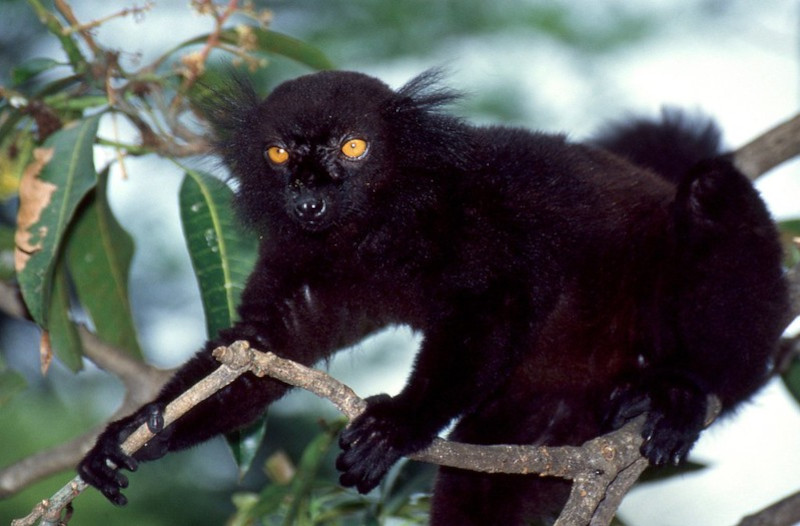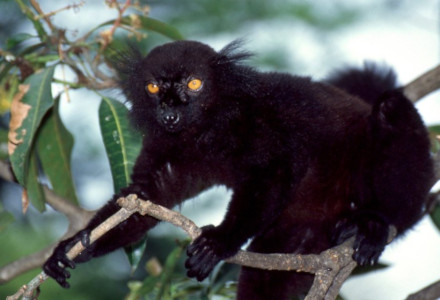
Black Lemur Facts
- This remarkable creation of evolution most frequently goes by the descriptive common name of the Black Lemur. Unlike the majority of animal species around the world, though, it presently has no other broadly accepted general title by which it’s known.
- Inside of the scientific community, however, it does have another name. That’s the technical appellation. Unfortunately, though, that’s somewhat difficult for the layperson to pronounce. That’s because it holds the official moniker of Eulemur macaco.
- It received that name due to the efforts of Carl Linnaeus. The esteemed Swedish Zoologist accomplished the first official recognition of it as a separate and distinct species. He managed that scientifically noteworthy deed in the year 1766.
- Experts previously believed two subspecies of the animal existed. Later research subsequently altered that belief, with two new individual species being recognized. The mammal nevertheless remains a fascinating creature on its own merits.
- Regrettably, the Black Lemur possesses a small population that seems to be continuing to decline. That unfortunate fact further appears to hold true throughout its range. Accordingly, the IUCN currently lists it as Critically Endangered on its Red List.
- It faces multiple threats to its continued existence as a species. Most of these stem from the actions of mankind. Its most immediate threats include deforestation and the exotic pet trade. It also now faces the looming danger posed by climate change.
Related Articles
Slow Loris Gray Mouse Lemur Tarsier
Black Lemur Physical Description
The stunning Black Lemur quickly captivates those fortunate enough to encounter one, especially in the wild. It does so primarily due to its appearance though, not sheer size. That’s due to the fact that. like most of its kindred, it’s not an overly large primate.
Visually, it truly distinguishes itself sharply from its relatives. That’s because this creature displays one of the most extreme degrees of the physiological characteristic of sexual dimorphism of any primate. In its case, this trait usually manifests itself in appearance.
The fur of males of the primate typically display a predominantly black pattern of coloring to the fur. This understandably serves as the origin of the common name. Despite this, though, some individuals present a background consisting of a dark chocolate brown hue.
Meanwhile, the females generally develop a sharply different pattern of color. In the case of this gender, the background most often consists of several shades of brown. This typically forms a blending of light, medium chestnut, and even orange-brown on occasion.
Males of the Black Lemur also manifest large black tufts of hair on their ears. Yet the females show white tufts in the same location. The creature additionally separates itself from others of its kind in an incredible way. It’s the only primate other than man to have blue eyes!
Both genders present virtually identical features otherwise. The average total head-to-tail length equals roughly 38 in (96 cm). However, the lengthy tail actually accounts for more than half of that. In terms of mass, the intriguing animal rarely exceeds 5 lb (2.25 kg)
- Kingdom: Animalia
- Phylum: Chordata
- Class: Mammalia
- Order: Primates
- Family: Lemuridae
- Genus: Eulemur
- Species: E. macaco
Black Lemur Distribution, Habitat, and Ecology
Lamentably, the amazing Black Lemur evolved as native to an extremely limited section of the globe. That exact location won’t surprise anyone who knows much about lemurs, though. That’s because this species, like all of its relatives, lives in only one place on earth.
This remarkable creation of Nature, along with its related species, developed as endemic almost solely to the island of Madagascar. A few specimens also appear on tiny nearby islands. This places the entire species, and related one’s, near the continent of Africa.
Even within this small zone of habitation, this creature only lives on the extreme northern part of the main island. It also displays decidedly strong preferences regarding its choice of habitat type. It principally makes its home in regions of undisturbed tropical rainforests.
The animal nonetheless also displays some degree of adaptibility in this respect. A relatively small percentage of individuals choose to live in local tree farms, and even on farmland. Sadly, though, this frequently brings it into interaction with human beings.
The Black Lemur is active during both day and night periods. It mainly forages for its food at night, though. While technically omnivorous, plants form the majority of its diet. Fruit comprises roughly 87% of its diet. It also eats leaves, flowers, and the rare invertebrate.
It’s a highly social animal, as well. The majority of individuals tend to live as social creatures, in groups numbering somewhere between 7 and 10 individuals. These small groups additionally tend to follow a single female, with infighting rarely occurring.
Species Sharing Its Range
Check out our other articles on 8 South American Geological Marvels, Yellow-Eyed Penguin, Blood Falls, Old Woman Cactus, Giant Mesquite Bug, Carolina Hammerhead Shark

